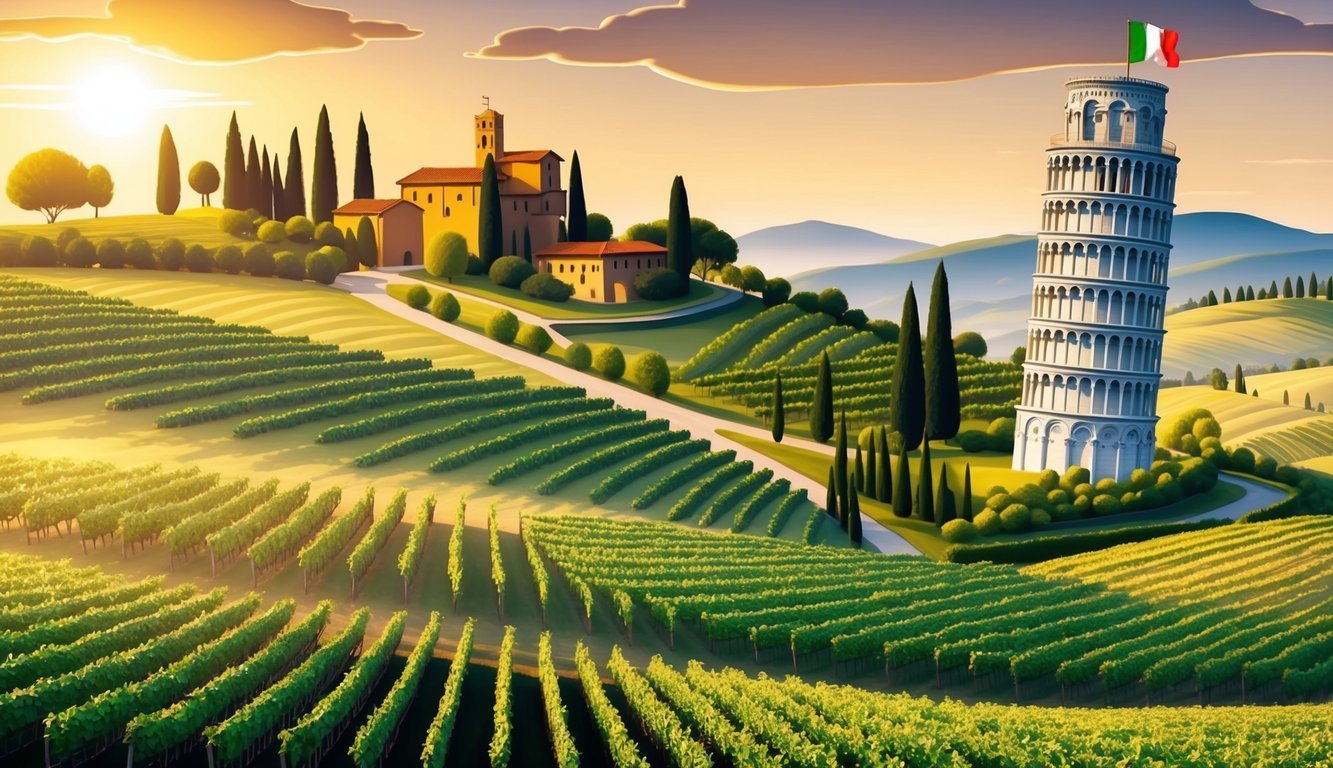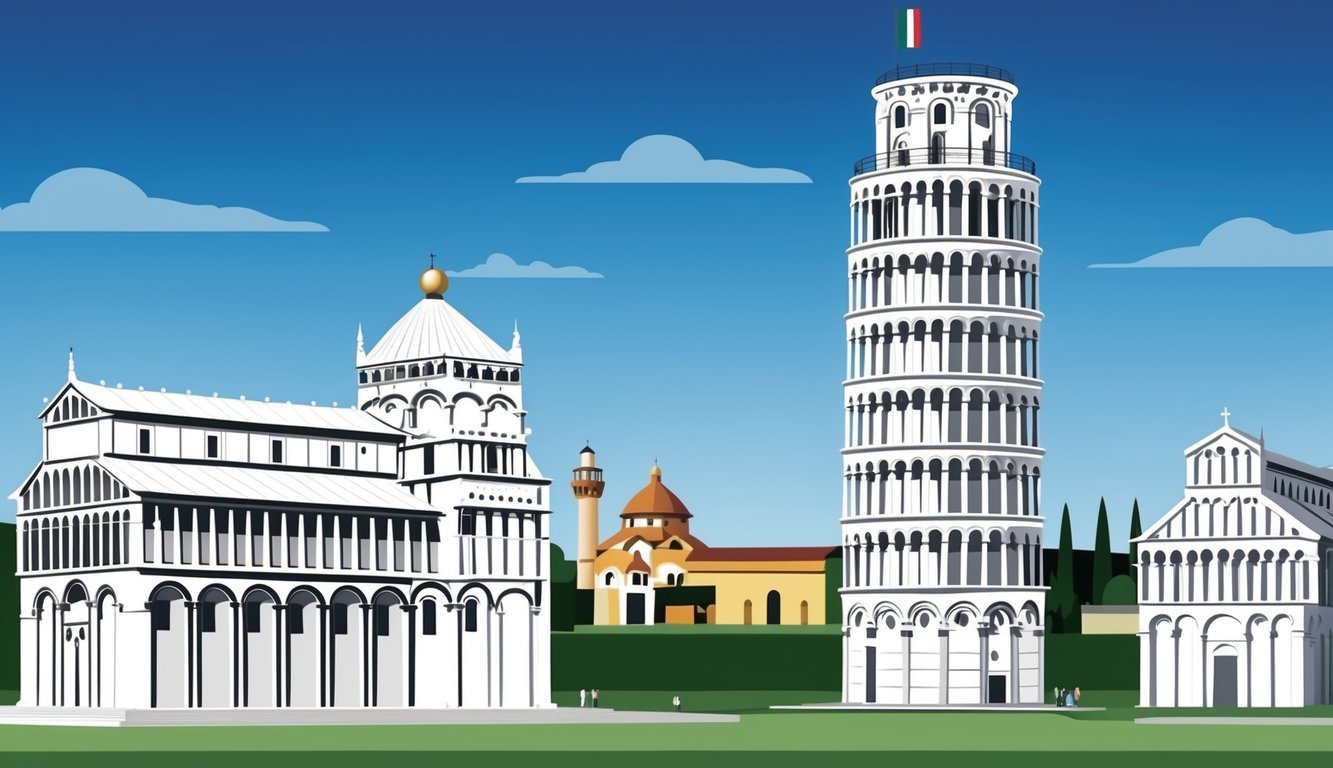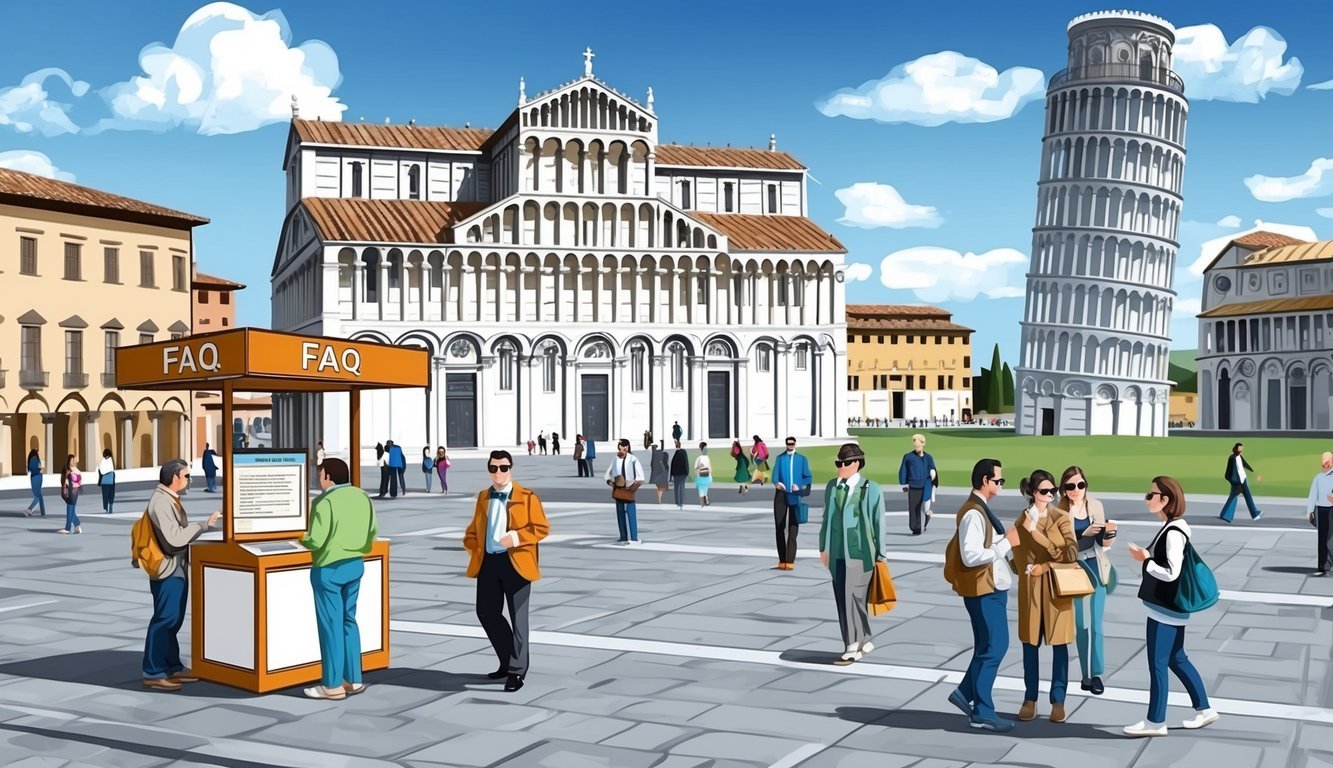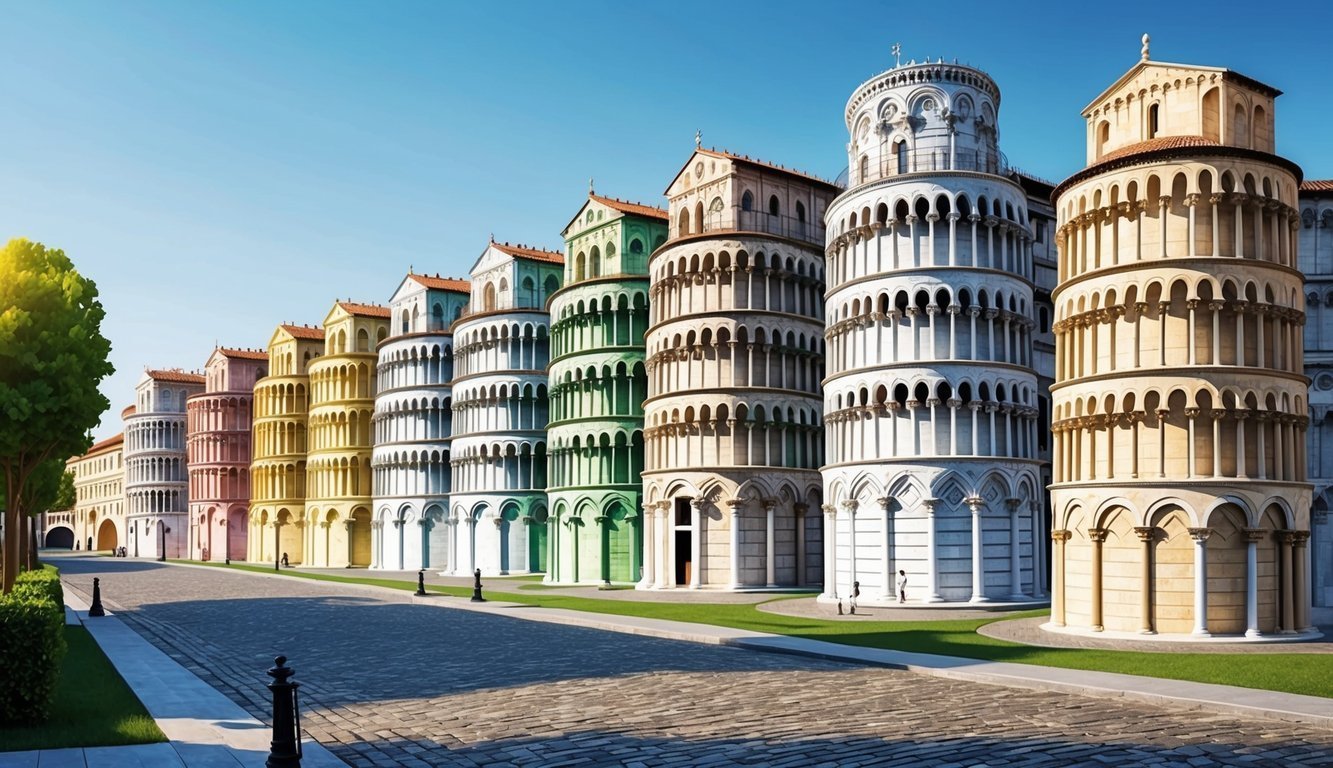Pisa, Italy, is not just the home of the famous Leaning Tower; it’s a city full of charm and rich history waiting for you to explore. This vibrant city offers everything from stunning medieval architecture to a lively culture, making it a great destination for travelers.
While many visitors stop by to snap a picture with the iconic tower, there’s so much more to discover in Pisa that often gets overlooked.
As you stroll through the picturesque streets, you’ll encounter breathtaking buildings, quaint piazzas, and delicious local cuisine.
The unique blend of historical sites and modern life adds to Pisa’s appeal, inviting you to stay longer than you may have initially planned.
You’ll want to learn about the city’s maritime past and how it shaped the region, along with experiencing some of the splendid art and architecture that define this lovely Italian town.
Whether you are an art enthusiast, a history buff, or just looking for a delightful getaway, Pisa has something special for everyone. This city is an essential stop for anyone traveling through Tuscany, bringing together captivating sights and experiences you won’t want to miss.
Key Takeaways
- Pisa is famous for its Leaning Tower and rich history.
- The city offers diverse local culture and delicious cuisine.
- Explore both historic sites and modern attractions for a complete experience.
Historical Overview
Pisa has a rich and varied history that spans from ancient times to the Renaissance.
You’ll find fascinating stories of its development through different eras, including its role as a Roman colony, its rise as a maritime power, and its cultural advancements during the Renaissance.
Ancient Beginnings
Pisa started as a Roman colony around the 2nd century BC, thriving due to its strategic location near the Arno River.
This river facilitated trade and connection with other regions.
The city was under Roman influence for several centuries, benefiting from the infrastructure and culture of the empire.
By the 5th century AD, however, it faced challenges from invading tribes, significantly changing its landscape.
Medieval Prosperity
During the Middle Ages, particularly the 11th and 12th centuries, Pisa transformed into a powerful maritime republic.
This era marked its peak in trade and political influence across the Mediterranean.
You’d see impressive architectural projects emerge, like the famous Leaning Tower, which was originally built as part of the cathedral complex.
The city was in constant competition with other maritime republics, such as Genoa and Venice, pushing it to develop a strong navy and trade routes.
The Medici family later played a key role in fostering this growth by patronizing the arts and architecture.
Renaissance and Beyond
The Renaissance brought a burst of creativity and cultural richness to Pisa.
Artists, architects, and scholars flocked to the city, inspired by its heritage and thriving environment.
This was the time when the city began to shift its focus toward education and the arts.
Notable figures, including Galileo Galilei, emerged from Pisa, contributing to science and philosophy.
The combination of its storied past and vibrant present makes Pisa a unique place to explore the history of Italy.
Iconic Landmarks
Pisa is home to several iconic landmarks that attract visitors from around the world.
These sites showcase the city’s rich history and beautiful architecture, making it a must-visit destination.
Leaning Tower of Pisa
The Leaning Tower of Pisa is probably the most famous landmark in the city.
This freestanding bell tower of the Cathedral of Santa Maria Assunta began leaning during its construction in the 12th century.
It stands about 56 meters tall and has eight stories.
You can climb its 294 steps for a unique view of the surrounding area.
Despite its tilt, the tower has remained stable over the years.
It’s a perfect spot for those iconic photos where you “hold up” the tower!
Piazza dei Miracoli
Piazza dei Miracoli, or the Square of Miracles, is a UNESCO World Heritage Site.
This beautiful square is home to the Tower of Pisa, the cathedral, and the baptistery.
The lush green grass surrounding these historical buildings provides a stunning backdrop for your photos.
Take your time to walk around and appreciate the intricate designs of the architecture, especially the marble detailing that defines this area.
Pisa Cathedral
The Pisa Cathedral, known as the Cathedral of Santa Maria Assunta, is a masterpiece of Romanesque architecture.
It features a stunning façade adorned with intricate carvings and beautiful mosaics.
Inside, you’ll find remarkable artwork and a magnificent pulpit carved by Giovanni Pisano.
The cathedral not only serves as a place of worship but also as a historical treasure that reflects the importance of Pisa in medieval times.
Pisa Baptistery
Next to the cathedral, the Pisa Baptistery stands out with its round shape and impressive height.
This structure is the largest baptistery in Italy.
Its exterior features a blend of Romanesque and Gothic styles, highlighted by the beautiful white marble.
The acoustics inside are remarkable, making for captivating sound experiments.
It’s a unique place to learn about baptism traditions and early Christian architecture.
Camposanto Monumentale
The Camposanto Monumentale, or the Monumental Cemetery, is another highlight in the Square of Miracles.
This historical cemetery dates back to the 13th century and is known for its beautiful cloisters and intricate tombs.
It holds the remains of famous figures and offers a serene place for reflection.
The frescoes that adorn its walls showcase biblical scenes and are significant works of art.
Don’t miss the chance to explore this peaceful spot.
University of Pisa
The University of Pisa, founded in 1343, is one of the oldest universities in Italy.
Its beautiful campus features historic buildings that reflect the city’s long academic tradition.
You can wander around and admire structures like the Palazzo Bo and the Aula Magna.
The university has a vibrant atmosphere with students and professors contributing to a lively intellectual environment that has influenced many fields.
Cultural Heritage
Pisa is rich in cultural heritage, offering a mix of art, lively festivals, and delicious gastronomy.
You’ll find unique museums, annual events, and local dishes that reflect the city’s history and traditions.
Art and Museums
Pisa boasts several must-see museums.
Start with the Museo Nazionale di San Matteo, which showcases an impressive collection of medieval and Renaissance art.
Here, you can admire works by renowned Italian artists.
Next, explore the Museo dell’Opera del Duomo, which houses treasures from the Cathedral and includes sculptures by important artists.
The Museo delle Sinopie displays fascinating sketches and preparatory drawings from the famous Camposanto Monumentale.
Don’t forget the Museum of Ancient Ships, where you can learn about Pisa’s maritime history.
Each museum provides a unique glimpse into the city’s artistic past.
Festivals and Events
Pisa hosts vibrant festivals that you should experience.
One of the most famous is the Luminara, held on June 16, to celebrate the city’s patron saint, San Ranieri.
The Arno River sparkles with thousands of candles, creating a magical atmosphere.
Another significant event is the Palio di San Ranieri, a thrilling boat race on the river.
Teams compete in colorful boats, showcasing local traditions and camaraderie.
The Knights of St. Stephen also play a role in local festivities, bringing history to life.
Be sure to check out these events when you visit, as they provide a great way to engage with the local culture.
Gastronomy
Pisa’s cuisine is a delightful fusion of flavors.
Start with a classic dish like Pici, a handmade pasta often served with garlic, tomato sauce, or meat.
It’s a comforting meal you can’t miss.
You can also enjoy Cecina, a savory chickpea pancake that’s crispy on the outside and soft inside.
Pair it with a glass of local wine for the perfect treat.
And don’t forget the delicious pastries! Try the Torta co’ bischeri, a sweet pie filled with chocolate and cream.
These dishes highlight the city’s culinary heritage and make for a tasty adventure during your visit.
Architectural Styles
Pisa boasts a rich blend of architectural styles that reflect its cultural history and significance.
You’ll find influences from Romanesque roots, striking Gothic elements, and touches from the Renaissance.
Each of these styles tells a story about the city’s development and artistry.
Pisan Romanesque
When you stroll through Pisa, you can’t miss the Pisan Romanesque style.
This style emerged in the 11th century and showcases thick walls, rounded arches, and decorative arcades.
The iconic Leaning Tower of Pisa is a prime example, featuring layered columns and a distinct, beautiful facade.
Buildings from this period often use local marble, which gives them a unique look.
It’s also common to see intricate carvings and sculptures that adorn entrances and walls.
The Cathedral of Pisa is another beautiful illustration, showcasing the robust yet ornate features typical of Romanesque architecture.
Gothic Influences
As you explore further, you’ll notice the shift to more vertical designs with Gothic influences, beginning in the 12th century.
This style emphasizes height and light, using pointed arches and ribbed vaults.
One notable example is the Pisa Cathedral.
Its façade is a fusion of Romanesque and early Gothic elements, creating a striking visual narrative.
Gothic architecture in Pisa also introduces large windows adorned with stained glass.
This allows more light into buildings, giving them an airy feel.
You may also find intricate stone details that enhance the overall beauty of each structure, showing a transition in design philosophy.
Renaissance Touches
In the 15th and 16th centuries, Renaissance touches began to appear, symbolizing a return to classical ideals.
You can see this in the use of symmetry and geometric shapes that characterize the period.
The Baptistery of St. John is a prime example with its harmonious proportions and elegant design.
Renaissance architecture in Pisa often includes ornate decoration and grand entrances.
Columns become more slender, and domes start to feature prominently.
As you walk around, pay attention to how these architectural styles blend together, creating a timeline of artistic evolution throughout the city.
Each corner turned in Pisa reveals a different facet of its architectural journey.
Exploring Pisa
Pisa is a city full of history and charm, perfect for exploring on foot or via day trips to nearby attractions.
You’ll find plenty of activities to keep you busy, from guided walking tours to exciting excursions outside the city.
Walking Tours
Walking tours are a great way to experience Pisa’s rich history.
You can visit iconic landmarks like the Leaning Tower of Pisa and the Cathedral of Santa Maria Assunta.
Local guides often share fascinating stories related to each site, so you get a full picture of what you’re seeing.
Many tours also include stops at less crowded spots, such as the Church of Santa Maria della Spina, which boasts stunning architecture and views of the Arno River.
You can choose from various themes, including historical walks or food tours.
A food tour allows you to sample local cuisine while taking in the sights.
Make sure to wear comfortable shoes, as you’ll be doing a lot of walking!
Day Trips and Excursions
If you want to venture beyond Pisa, you can find plenty of day trips available.
A popular choice is visiting Lucca, just 30 minutes away by train.
This charming town has well-preserved medieval walls, quaint streets, and delicious food.
Another option is Cinque Terre, a stunning coastline with colorful villages.
It’s a bit farther away but worth the journey for the breathtaking views and hiking trails.
You can also check out Tuscan vineyards with wine-tasting tours that showcase the region’s best.
These excursions provide a taste of the local culture and landscapes, making your trip even more memorable.
Surrounding Regions

Pisa is a gateway to beautiful regions and vibrant cities in Tuscany.
Exploring the surroundings reveals stunning landscapes and charming towns, each offering unique experiences.
Tuscan Landscapes
Tuscany is famous for its breathtaking scenery.
Rolling hills, golden fields, and vineyards stretch as far as the eye can see.
The Arno River winds through this landscape, adding charm and beauty.
Visiting nearby areas like Montecatini offers relaxation with its spa culture.
You can explore historic sites, such as the ancient city walls of Lucca, known as the Mura di Pisa.
Don’t forget to take a drive to Grosseto, where the countryside meets the coast.
The area is dotted with olive groves and cypress trees, showcasing classic Tuscan beauty.
Nearby Cities
Florence is just a short trip from Pisa.
Known as the birthplace of the Renaissance, it’s filled with art, history, and great food.
Must-see spots include the Uffizi Gallery and the iconic Florence Cathedral.
Lucca, with its preserved Renaissance walls, is perfect for a stroll or a bike ride.
You can also enjoy some local cuisine at its quaint restaurants.
Livorno, a port city, is famous for its seafood and beautiful waterfront.
Enjoy a day by the sea or explore Pistoia, known for its lively markets and rich history.
Each nearby city offers its own taste of Tuscan culture and charm.
Modern Pisa

Pisa today is a vibrant mix of education, research, and modern amenities.
The city has a strong academic presence and growing economy, making it a great place to live and study.
Education and Research
Education is a big deal in Pisa.
The University of Pisa is one of the oldest in Italy, founded in 1343.
It offers a wide range of programs and attracts students from all over the world.
This creates a lively atmosphere that benefits the entire city.
Another notable institution is the Scuola Normale Superiore di Pisa, a prestigious research university.
This school focuses on advanced studies and has a strong reputation for science and humanities.
Both institutions contribute to Pisa’s drive for innovation and excellence.
Economy and Infrastructure
Pisa’s economy is thriving, thanks in part to its educational institutions.
A well-educated workforce supports local businesses and startups.
The Commercial Centre in Pisa also plays a crucial role, offering shopping and dining options that cater to residents and visitors alike.
Don’t forget about Pisa Airport, which connects the city to various destinations across Europe.
It’s convenient for both travelers and locals.
The blend of education and commerce makes modern Pisa a dynamic place that keeps evolving.
Frequently Asked Questions

You might have a few questions about your trip to Pisa.
Let’s dive into some common queries about attractions, dining, accommodations, and travel tips to make your visit enjoyable.
What are the top attractions to visit in Pisa?
You can’t miss the famous Leaning Tower of Pisa.
Climb the 294 steps for breathtaking views.
Also, check out the stunning Cathedral and the Baptistery in the Piazza dei Miracoli.
These sites showcase remarkable architecture and history.
Can you recommend some good places to eat in Pisa?
When you’re hungry, try Trattoria Da Bruno for traditional Tuscan dishes.
Another great spot is Osteria dei Latticini, known for its delicious local cheeses and fresh pasta.
Both places offer a cozy atmosphere perfect for a meal after sightseeing.
Where can I find the best deals on accommodation in Pisa?
For budget stays, look at options like hostels or guesthouses near the city center.
Websites like Booking.com or Airbnb can help you score some good rates.
If you book in advance, you might find a deal that fits your budget.
What’s the best way to get from Pisa to Florence?
Traveling from Pisa to Florence is easy.
You can take a train from Pisa Centrale, which takes about an hour.
Trains run frequently, about every 20 to 30 minutes, so you can choose a time that works for you.
Which month is ideal for visiting Pisa to avoid crowds?
If you want to avoid busy tourist seasons, consider visiting Pisa in the late fall, like October or November.
The weather is still pleasant, and there are fewer crowds, giving you a better experience at popular sites.
Are there any hidden gems near Pisa that tourists often overlook?
Just a short drive from Pisa, you can explore Parco Regionale Migliarino San Rossore Massaciuccoli.
This nature preserve features beautiful landscapes with pine forests and sandy beaches.
It’s a perfect spot for a peaceful escape from the city buzz.

